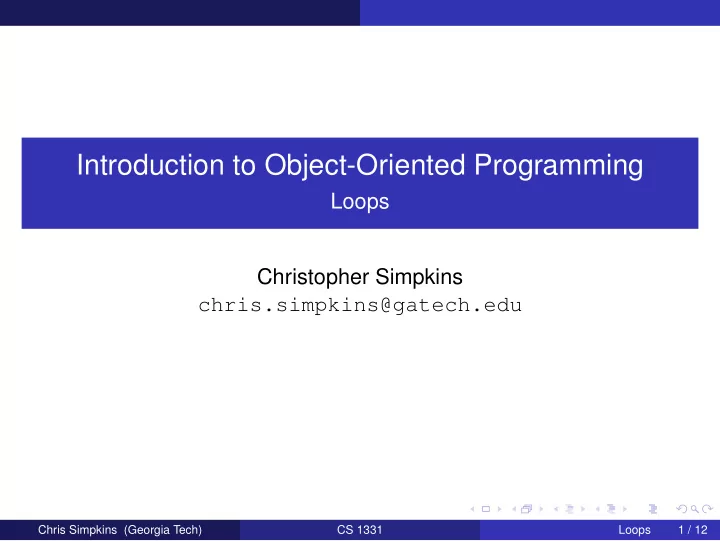

Introduction to Object-Oriented Programming Loops Christopher Simpkins chris.simpkins@gatech.edu Chris Simpkins (Georgia Tech) CS 1331 Loops 1 / 12
Chris Simpkins (Georgia Tech) CS 1331 Loops 2 / 12
Loops and Iteration Algorithms often call for repeated action or iteration, e.g. : “repeat ... while (or until) some condition is true” (looping) or “for each element of this array/list/etc. ...” (iteration) Java provides three iteration structures: while loop do-while loop for iteration statement Chris Simpkins (Georgia Tech) CS 1331 Loops 3 / 12
while and do-while while loops are pre-test loops: the loop condition is tested before the loop body is executed while (condition) { // condition is any boolean expression // loop body executes as long as condition is true } do-while loops are post-test loops: the loop condition is tested after the loop body is executed do { // loop body executes as long as condition is true } while (condition) The body of a do-while loop will always execute at least once. Chris Simpkins (Georgia Tech) CS 1331 Loops 4 / 12
for Statements The general for statement syntax is: for( initializer ; condition ; update ) { // body executed as long as condition is true } intializer is a statement Use this statement to initialize value of the loop variable(s) condition is tested before executing the loop body to determine whether the loop body should be executed. When false, the loop exits just like a while loop update is a statement Use this statement to update the value of the loop variable(s) so that the condition converges to false Chris Simpkins (Georgia Tech) CS 1331 Loops 5 / 12
for Statement vs. while Statement The for statement: for( int i = 0 ; i < 10 ; i++ ) { // body executed as long as condition is true } is equivalent to: int i = 0 while ( i < 10 ) { // body i++ ; } for is Java’s primary iteration structure. In the future we’ll see generalized versions, but for now for statements are used primarily to iterate through the indexes of data structures and to repeat code a particular number of times. Chris Simpkins (Georgia Tech) CS 1331 Loops 6 / 12
for Statement Examples Here’s an example from CharCount.java. We use the for loop’s index variable to visit each character in a String and count the digits and letters: int digitCount = 0, letterCount = 0; for (int i = 0; i < input.length(); ++i) { char c = input.charAt(i); if (Character.isDigit(c)) digitCount++; if (Character.isAlphabetic(c)) letterCount++; } And here’s a simple example of repeating an action a fixed number of times: for (int i = 0; i < 10; ++i) System.out.println("Meow!"); Chris Simpkins (Georgia Tech) CS 1331 Loops 7 / 12
for Statement Subtleties Better to declare loop index in for to limit it’s scope. Prefer: for (int i = 0; i < 10; ++i) to: int i; // Bad. Looop index variable visible outside loop. for (i = 0; i < 10; ++i) You can have multiple loop indexes separated by commas: String mystery = "mnerigpaba", solved = ""; int len = mystery.length(); for (int i = 0, j = len - 1; i < len/2; ++i, --j) { solved = solved + mystery.charAt(i) + mystery.charAt(j); } Note that the loop above is one loop, not nested loops. Beware of common “extra semicolon” syntax error: for (int i = 0; i < 10; ++i); // oops! semicolon ends the statement print(meow); // this will only execute once, not 10 times Chris Simpkins (Georgia Tech) CS 1331 Loops 8 / 12
Forever Note that in the context of programming, infinite means “as long as the program is running.” Here are two idioms for infinite loops. First with for : for (;;) { // ever } and with while : while (true) { // forever } Infinite loops are useful for things like game loops and operating system routines that poll input buffers or wait for incoming network connections. In both of these cases the loop is inteded to run for the duration of the program. See Loops.java for loop examples. Chris Simpkins (Georgia Tech) CS 1331 Loops 9 / 12
break and continue Java provides two non-structured-programming ways to alter loop control flow: break exits the loop, possibly to a labeled location in the program continue skips the remainder of a loop body and continues with the next iteration Consider the following while loop: boolean shouldContinue = true; while (shouldContinue) { System.out.println("Enter some input (exit to quit):"); String input = System.console().readLine(); doSomethingWithInput(input); // We do something with "exit" too. shouldContinue = (input.equalsIgnoreCase("exit")) ? false : true; } We don’t test for the termination sentinal, “exit,” until after we do something with it. Situations like these often tempt us to use break ... Chris Simpkins (Georgia Tech) CS 1331 Loops 10 / 12
break ing out of a while Loop We could test for the sentinal and break before processing: boolean shouldContinue = true; while (shouldContinue) { System.out.println("Enter some input (exit to quit):"); String input = System.console().readLine(); if (input.equalsIgnoreCase("exit")) break; doSomethingWithInput(input); } But it’s better to use structured programming: boolean shouldContinue = true; while (shouldContinue) { System.out.println("Enter some input (exit to quit):"); String input = System.console().readLine(); if (input.equalsIgnoreCase("exit")) { shouldContinue = false; } else { doSomethingWithInput(input); } } Chris Simpkins (Georgia Tech) CS 1331 Loops 11 / 12
Programming Exercise: Palindromes Write a program that determines whether a String is a palindrome. A palindrome is a string of characters that reads the same when reversed, e.g. “radar”. Your program should use the first command line argument as the String to test You should ignore case, e.g. ’R’ == ’r’ You should ignore spaces, e.g. “a but tuba” is a palindrome Try to do this with a single for loop Chris Simpkins (Georgia Tech) CS 1331 Loops 12 / 12
Recommend
More recommend